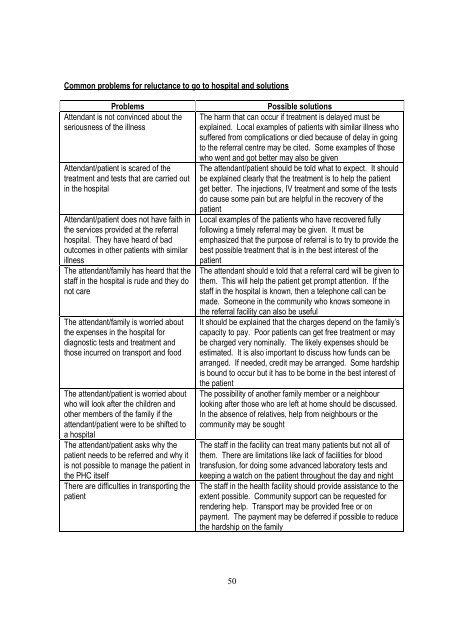training module for medical officers primary health centre - NVBDCP
training module for medical officers primary health centre - NVBDCP
training module for medical officers primary health centre - NVBDCP
- No tags were found...
Create successful ePaper yourself
Turn your PDF publications into a flip-book with our unique Google optimized e-Paper software.
Common problems <strong>for</strong> reluctance to go to hospital and solutionsProblemsAttendant is not convinced about theseriousness of the illnessAttendant/patient is scared of thetreatment and tests that are carried outin the hospitalAttendant/patient does not have faith inthe services provided at the referralhospital. They have heard of badoutcomes in other patients with similarillnessThe attendant/family has heard that thestaff in the hospital is rude and they donot careThe attendant/family is worried aboutthe expenses in the hospital <strong>for</strong>diagnostic tests and treatment andthose incurred on transport and foodThe attendant/patient is worried aboutwho will look after the children andother members of the family if theattendant/patient were to be shifted toa hospitalThe attendant/patient asks why thepatient needs to be referred and why itis not possible to manage the patient inthe PHC itselfThere are difficulties in transporting thepatientPossible solutionsThe harm that can occur if treatment is delayed must beexplained. Local examples of patients with similar illness whosuffered from complications or died because of delay in goingto the referral <strong>centre</strong> may be cited. Some examples of thosewho went and got better may also be givenThe attendant/patient should be told what to expect. It shouldbe explained clearly that the treatment is to help the patientget better. The injections, IV treatment and some of the testsdo cause some pain but are helpful in the recovery of thepatientLocal examples of the patients who have recovered fullyfollowing a timely referral may be given. It must beemphasized that the purpose of referral is to try to provide thebest possible treatment that is in the best interest of thepatientThe attendant should e told that a referral card will be given tothem. This will help the patient get prompt attention. If thestaff in the hospital is known, then a telephone call can bemade. Someone in the community who knows someone inthe referral facility can also be usefulIt should be explained that the charges depend on the family’scapacity to pay. Poor patients can get free treatment or maybe charged very nominally. The likely expenses should beestimated. It is also important to discuss how funds can bearranged. If needed, credit may be arranged. Some hardshipis bound to occur but it has to be borne in the best interest ofthe patientThe possibility of another family member or a neighbourlooking after those who are left at home should be discussed.In the absence of relatives, help from neighbours or thecommunity may be soughtThe staff in the facility can treat many patients but not all ofthem. There are limitations like lack of facilities <strong>for</strong> bloodtransfusion, <strong>for</strong> doing some advanced laboratory tests andkeeping a watch on the patient throughout the day and nightThe staff in the <strong>health</strong> facility should provide assistance to theextent possible. Community support can be requested <strong>for</strong>rendering help. Transport may be provided free or onpayment. The payment may be deferred if possible to reducethe hardship on the family50
















